First Look: AM2 DDR2 vs. 939 DDR Performance
by Wesley Fink on April 17, 2006 12:05 AM EST- Posted in
- CPUs
Comparing Overclocked Gaming Performance
We've also compared Real-world gaming results at the overclocked 10x250 processor speed at DDR2-833 3-3-3 memory speed and DDR500 3-3-3 memory speed. As in the overclocked memory comparisons, stock DDR400 2-2-2 and stock DDR2-800 3-3-3 gaming performance are included for a better comparison. The benchmark results are particularly interesting when you consider that the two overclocked results represent a 25% processor speed increase over the stock performance results. The massive increases in memory bandwidth and the significant latency reduction in overclocking still do not have much impact on real-world gaming performance. Results are certainly improved, but they are not 25% higher as you might expect with this kind of overclock.
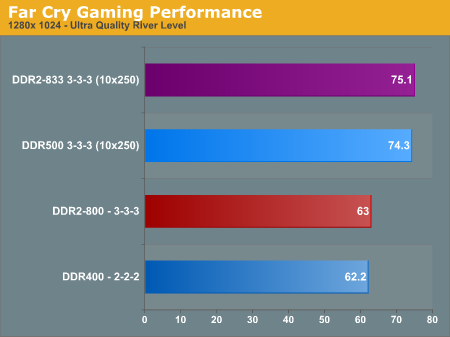
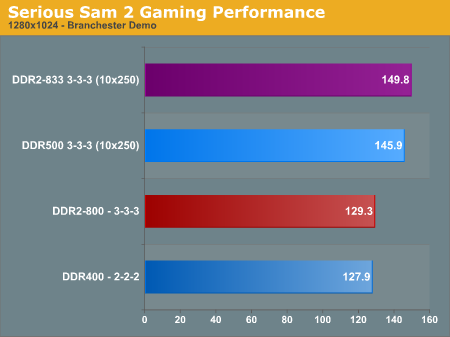
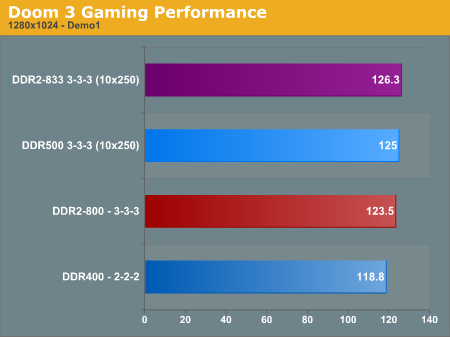
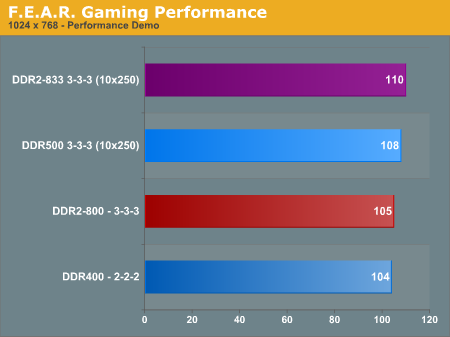
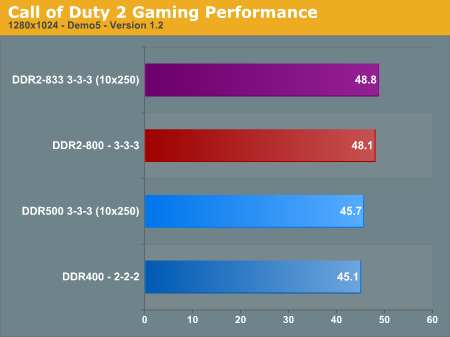
We've also compared Real-world gaming results at the overclocked 10x250 processor speed at DDR2-833 3-3-3 memory speed and DDR500 3-3-3 memory speed. As in the overclocked memory comparisons, stock DDR400 2-2-2 and stock DDR2-800 3-3-3 gaming performance are included for a better comparison. The benchmark results are particularly interesting when you consider that the two overclocked results represent a 25% processor speed increase over the stock performance results. The massive increases in memory bandwidth and the significant latency reduction in overclocking still do not have much impact on real-world gaming performance. Results are certainly improved, but they are not 25% higher as you might expect with this kind of overclock.















37 Comments
View All Comments
phial - Thursday, July 5, 2007 - link
"Comments are often made that any evaluation of AM2 should include overclocking. Those theorists argue that the faster processor clock will move AM2 to the higher "bus" speeds that make for better efficiencies of the DDR2 memory controller - or something along those lines."OK who hired this guy? He knows NOT what he speaks of. Its apparent through the entire review.
phial - Wednesday, July 4, 2007 - link
"This will likely shift to patterns similar to those seen in bandwidth positioning as the AM2 memory controller is further refined and game patches make better use of AM2 capabilities."Wow... and your posting hardware reviews on a high traffic website.. amazing...
Zebo - Tuesday, April 18, 2006 - link
I get everest of 42ns 2-2-2 @ 200 with FX60 speeds on DFI NF4. I get 36ns when cranking up to 250mhz 2-2-2. And that reminds me - I guess you did'nt want to embarres AMD's new chip too much by putting old, supported, DDR 550 @ 2-2-2 in there huh?What a dog this change is.
Wesley Fink - Wednesday, April 19, 2006 - link
Actually our Beta motherboard and CPU were not 100% stable at 275. Also I don't have any memory that will do DDR550 (275 clock speed) at 2-2-2. Perhaps you mean another speed or other timings.Our Crucial 2GB kit can do DDR500 at 3-2-3 timings, but our DDR2-800 memory is also capable of doing 3-2-3 at some speeds if the beta motherboard had supported those timings. That's the reason we compared 3-3-3 500, which should be very very close to each memory's top performance and a fair comparison.
Our latency testing was at a slower speed than your FX60, which is why you got lower latency numbers. We did, however, set both the DDR and DDR2 platforms to the exact same speed and ratios for all the benchmarking. The results comparison was as fair as we could make it.
spinportal - Tuesday, April 18, 2006 - link
Let's see.. the 1GB PC-4400 DDR-550 kit is roughly 200$US for 2.5-3-3 timing. The DDR2-667 PC-5300 1GB kit is ~180$US for 3-3-3 timing for use to OC to DDR2-833. Unless I'm missing something, I don't understand your beef about spending $20 more for equal performance and using more juice.puffpio - Monday, April 17, 2006 - link
I can see gaming benchmarks being VERY graphics and cpu calculation intensive...but in terms of the bus between the cpu and main memory..i dont see it as that intentive
I wonder if a multitasking benchmark w/ lots of datasets would show off the increased bandwidth? (giant spreadsheets, databases, image processing, video encoding, etc etc)
shady28 - Tuesday, April 18, 2006 - link
"Real world" single user and light multitasking apps aren't going to use up the bandwidth. A heavy duty multitasking environment is what's needed to really test the benefits of dual core + DDR2. The thing is, this doesn't really describe what most PCs spend 99% of their time doing.
That said, Conroe does look promising, and I'm interested to see what AMD can come up with to counter it. The initial performance advantages, according to *Intel* benchmarks, are pretty significant. Hopefully AM2 is just laying the groundwork for faster processors from AMD. Still, I can't help but think the performance boosts we've been getting since about 2001 (3.06Ghz P4 HT) are marginal, and that this is yet another marginal boost.
NullSubroutine - Monday, April 17, 2006 - link
I am still convinced that the transition from DDR to DDR2 is primiarily because it unifies the memory production industry, lowers power for server and mobile areans, increases memory bandwidth for upcoming memory hog (ie vista), and servers as a platform of increased memory capability. As for the last point I think most of us believe that quad core CPU's may use more memory bandwidth and the original DDR may act as a bottleneck for the system. I also think it is clear that memory bandwidth is not a bottleneck for AMD, but I applaud them taking care of a potential bottleneck before it exists, unlike Intel who has continuelly bottlenecked their CPUs by insuffient memory bandwidth.NullSubroutine - Monday, April 17, 2006 - link
should say serves obviously.
eRacer - Sunday, April 16, 2006 - link
Was the DDR2 using a 2T command rate and was the DDR-400 tested using 1T? Is there an option to change the command rate on the AM2 motherboards? I believe at least some Pentium DDR2 motherboards with NVIDIA chipsets have the option to use a 1T command rate.I've seen some Sandra 2005 standard memory tests gain 500MB/s or more just by using 1T instead of 2T. A gain like that would allow DDR2-533 1T to score higher than DDR2-800 2T in the Sandra 2005 standard memory test. If DDR2-800 could use a 1T command rate the performance gain in the non-synthetic benchmarks might be a few percent higher on average. While that doesn't sound like much it would be roughly double the DDR2-800 performance advantage over DDR-400 in this review.